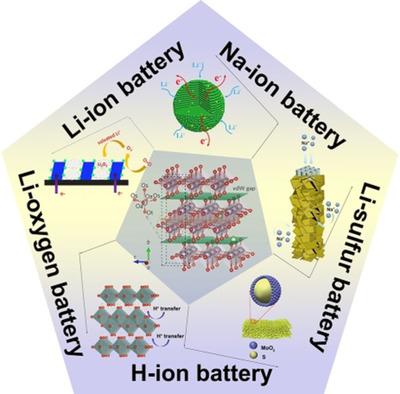当前位置:
X-MOL 学术
›
ChemSusChem
›
论文详情
Our official English website, www.x-mol.net, welcomes your
feedback! (Note: you will need to create a separate account there.)
Recent Progress on Molybdenum Oxides for Rechargeable Batteries
ChemSusChem ( IF 7.5 ) Pub Date : 2019-02-07 , DOI: 10.1002/cssc.201801860 Kai Tang 1, 2, 3 , Sidra Anis Farooqi 1, 2, 3 , Xianfu Wang 1, 2, 3 , Chenglin Yan 1, 2, 3
ChemSusChem ( IF 7.5 ) Pub Date : 2019-02-07 , DOI: 10.1002/cssc.201801860 Kai Tang 1, 2, 3 , Sidra Anis Farooqi 1, 2, 3 , Xianfu Wang 1, 2, 3 , Chenglin Yan 1, 2, 3
Affiliation

|
Diminishing fossil‐fuel resources and a rise in energy demands has required the pursuit of sustainable and rechargeable energy‐storage materials, including batteries and supercapacitors, the electrochemical properties of which depend largely on the electrode materials. In recent decades, numerous electrode materials with excellent electrochemical energy‐storage capabilities, long life spans, and environmentally acceptable qualities have been developed. Among existing materials, molybdenum oxides containing MoO3 and MoO2, as well as their composites, are very fascinating contenders for competent energy‐storage devices because of their exceptional physicochemical properties, such as thermal stability, high theoretical capability, and mechanical strength. This Minireview mainly focuses on the latest progress for the use of molybdenum oxides as electrode materials for lithium‐ion batteries; sodium‐ion batteries; and other novel batteries, such as lithium–sulfur batteries, lithium–oxygen batteries, and newly developed hydrogen‐ion batteries, with a focus on studies of the reaction mechanism, design of the electrode structures, and improvement of the electrochemical properties.
中文翻译:

充电电池用氧化钼的最新进展
化石燃料资源的减少和能源需求的增长,要求人们寻求可持续的可充电储能材料,包括电池和超级电容器,其电化学性能在很大程度上取决于电极材料。近几十年来,已经开发出了许多电极材料,它们具有出色的电化学储能能力,长寿命和环境可接受的质量。在现有材料中,包含MoO 3和MoO 2的氧化钼以及它们的复合材料,因其出色的理化特性(例如热稳定性,高理论能力和机械强度)而成为出色的能量存储设备的极具吸引力的竞争者。这份小型审查主要关注使用氧化钼作为锂离子电池电极材料的最新进展。钠离子电池;以及其他新型电池,例如锂硫电池,锂氧电池和新近开发的氢离子电池,重点是研究反应机理,电极结构设计和改善电化学性能。
更新日期:2019-02-07
中文翻译:

充电电池用氧化钼的最新进展
化石燃料资源的减少和能源需求的增长,要求人们寻求可持续的可充电储能材料,包括电池和超级电容器,其电化学性能在很大程度上取决于电极材料。近几十年来,已经开发出了许多电极材料,它们具有出色的电化学储能能力,长寿命和环境可接受的质量。在现有材料中,包含MoO 3和MoO 2的氧化钼以及它们的复合材料,因其出色的理化特性(例如热稳定性,高理论能力和机械强度)而成为出色的能量存储设备的极具吸引力的竞争者。这份小型审查主要关注使用氧化钼作为锂离子电池电极材料的最新进展。钠离子电池;以及其他新型电池,例如锂硫电池,锂氧电池和新近开发的氢离子电池,重点是研究反应机理,电极结构设计和改善电化学性能。











































 京公网安备 11010802027423号
京公网安备 11010802027423号